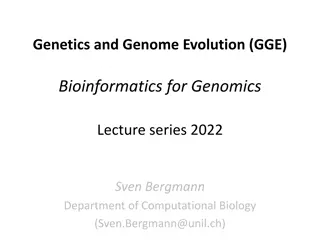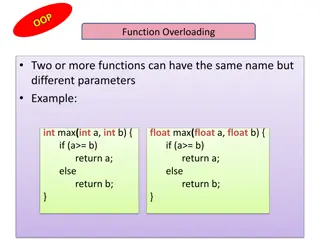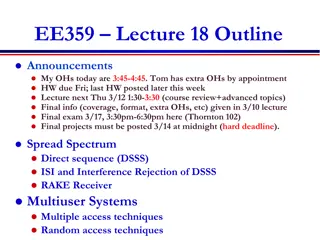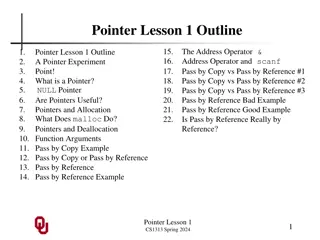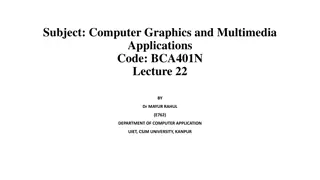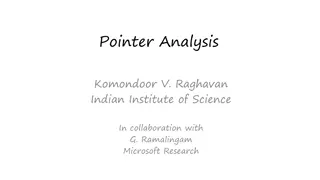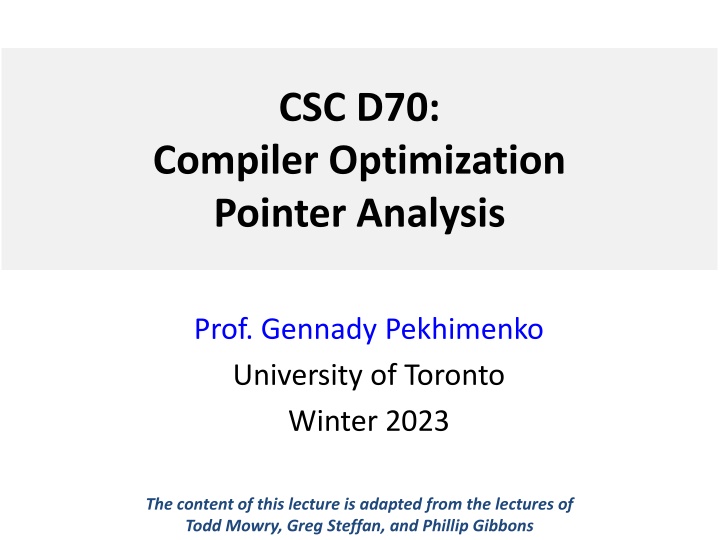
Compiler Optimization and Pointer Analysis in the University of Toronto's Winter 2023 Lecture
Explore the fundamentals of compiler optimization and pointer analysis in this informative lecture presented by Prof. Gennady Pekhimenko at the University of Toronto. Learn about the basics, design options, algorithms, and practical uses of pointer analysis. Discover the challenges, benefits, and applications of analyzing pointers in programming languages like C and C++.
Download Presentation

Please find below an Image/Link to download the presentation.
The content on the website is provided AS IS for your information and personal use only. It may not be sold, licensed, or shared on other websites without obtaining consent from the author. If you encounter any issues during the download, it is possible that the publisher has removed the file from their server.
You are allowed to download the files provided on this website for personal or commercial use, subject to the condition that they are used lawfully. All files are the property of their respective owners.
The content on the website is provided AS IS for your information and personal use only. It may not be sold, licensed, or shared on other websites without obtaining consent from the author.
E N D
Presentation Transcript
CSC D70: Compiler Optimization Pointer Analysis Prof. Gennady Pekhimenko University of Toronto Winter 2023 The content of this lecture is adapted from the lectures of Todd Mowry, Greg Steffan, and Phillip Gibbons
Outline Basics Design Options Pointer Analysis Algorithms Pointer Analysis Using BDDs Probabilistic Pointer Analysis 2
Pros and Cons of Pointers Many procedural languages have pointers e.g., C or C++: int *p = &x; Pointers are powerful and convenient can build arbitrary data structures Pointers can also hinder compiler optimization hard to know where pointers are pointing must be conservative in their presence Has inspired much research analyses to decide where pointers are pointing many options and trade-offs open problem: a scalable accurate analysis 3
Pointer Analysis Basics: Aliases Two variables are aliases if: they reference the same memory location More useful: prove variables reference different location Alias Sets ? {x, *p, *r} {y, *q, **s} {q, *s} int x,y; int *p = &x; int *q = &y; int *r = p; int **s = &q; p and q point to different locs 4
The Pointer Alias Analysis Problem Decide for every pair of pointers at every program point: do they point to the same memory location? A difficult problem shown to be undecidable by Landi, 1992 Correctness: report all pairs of pointers which do/may alias Ambiguous: two pointers which may or may not alias Accuracy/Precision: how few pairs of pointers are reported while remaining correct i.e., reduce ambiguity to improve accuracy 5
Many Uses of Pointer Analysis Basic compiler optimizations register allocation, CSE, dead code elimination, live variables, instruction scheduling, loop invariant code motion, redundant load/store elimination Parallelization instruction-level parallelism thread-level parallelism Behavioral synthesis automatically converting C-code into gates Error detection and program understanding memory leaks, wild pointers, security holes 6
Challenges for Pointer Analysis Complexity: huge in space and time compare every pointer with every other pointer at every program point potentially considering all program paths to that point Scalability vs. accuracy trade-off different analyses motivated for different purposes many useful algorithms (adds to confusion) Coding corner cases pointer arithmetic (*p++), casting, function pointers, long-jumps Whole program? most algorithms require the entire program library code? optimizing at link-time only? 7
Pointer Analysis: Design Options Representation Heap modeling Aggregate modeling Flow sensitivity Context sensitivity 8
Alias Representation **a Track pointer aliases <*a, b>, <*a, e>, <b, e> <**a, c>, <**a, d>, More precise, less efficient *a a *b *e b e c d Track points-to info <a, b>, <b, c>, <b, d>, <e, c>, <e, d> Less precise, more efficient Why? a b c e d a = &b; b = &c; b = &d; e = b; 9
Heap Modeling Options Heap merged i.e. no heap modeling Allocation site (any call to malloc/calloc) Consider each to be a unique location Doesn t differentiate between multiple objects allocated by the same allocation site Shape analysis Recognize linked lists, trees, DAGs, etc. 10
Aggregate Modeling Options Arrays Structures Elements are treated as individual locations Elements are treated as individual locations ( field sensitive ) or Treat entire array as a single location or or Treat first element separate from others Treat entire structure as a single location What are the tradeoffs? 11
Flow Sensitivity Options Flow insensitive The order of statements doesn t matter Result of analysis is the same regardless of statement order Uses a single global state to store results as they are computed Not very accurate Flow sensitive The order of the statements matter Need a control flow graph Must store results for each program point Improves accuracy Path sensitive Each path in a control flow graph is considered 12
Flow Sensitivity Example (assuming allocation-site heap modeling) Flow Insensitive aS7 {heapS1, heapS2, heapS4, heapS6} S1: a = malloc( ); S2: b = malloc( ); S3: a = b; S4: a = malloc( ); S5: if(c) a = b; S6: if(!c) a = malloc( ); S7: = *a; (order doesn t matter, union of all possibilities) Flow Sensitive aS7 {heapS2, heapS4, heapS6} (in-order, doesn t know s5 & s6 are exclusive) Path Sensitive aS7 {heapS2, heapS6} (in-order, knows s5 & s6 are exclusive) 13
Context Sensitivity Options Context insensitive/sensitive whether to consider different calling contexts e.g., what are the possibilities for p at S6? Context Insensitive: int f() { S4: p = &b; S5: g(); } pS6 => {a,b} int a, b, *p; int main() { S1: f(); S2: p = &a; S3: g(); } Context Sensitive: int g() { S6: = *p; } Called from S5:pS6 => {b} Called from S3:pS6 => {a} 14
Pointer Alias Analysis Algorithms References: Points-to analysis in almost linear time , Steensgaard, POPL 1996 Program Analysis and Specialization for the C Programming Language , Andersen, Technical Report, 1994 Context-sensitive interprocedural points-to analysis in the presence of function pointers , Emami et al., PLDI 1994 Pointer analysis: haven't we solved this problem yet? , Hind, PASTE 2001 Which pointer analysis should I use? , Hind et al., ISSTA 2000 Introspective analysis: context-sensitivity, across the board , Smaragdakiset al., PLDI 2014 Sparse flow-sensitive pointer analysis for multithreaded programs , Sui et al., CGO 2016 Symbolic range analysis of pointers , Paisanteet al., CGO 2016 15
Address Taken Basic, fast, ultra-conservative algorithm flow-insensitive, context-insensitive often used in production compilers Algorithm: Generate the set of all variables whose addresses are assigned to another variable. Assume that any pointer can potentially point to any variable in that set. Complexity: O(n) - linear in size of program Accuracy: very imprecise 16
Address Taken Example T *p, *q, *r; g(T **fp) { T local; if( ) s9: p = &local; } int main() { S1: p = alloc(T); f(); g(&p); S4: p = alloc(T); S5: = *p; } void f() { S6: q = alloc(T); g(&q); S8: r = alloc(T); } pS5 = {heap_S1, p, heap_S4, heap_S6, q, heap_S8, local} 17
Andersens Algorithm Flow-insensitive, context-insensitive, iterative Representation: one points-to graph for entire program each node represents exactly one location For each statement, build the points-to graph: y = &x y = x y points-to x if x points-to w then y points-to w if y points-to z and x points-to w then z points-to w if x points-to z and z points-to w then y points-to w *y = x y = *x Iterate until graph no longer changes Worst case complexity: O(n3), where n = program size 18
Andersen Example T *p, *q, *r; g(T **fp) { T local; if( ) s9: p = &local; } int main() { S1: p = alloc(T); f(); g(&p); S4: p = alloc(T); S5: = *p; } void f() { S6: q = alloc(T); g(&q); S8: r = alloc(T); } pS5 = {heap_S1, heap_S4, local} 19
Andersen Example T *p, *q, *r; g(T **fp) { T local; if( ) s9: p = &local; } int main() { S1: p = alloc(T); f(); g(&p); S4: p = alloc(T); S5: = *p; } void f() { S6: q = alloc(T); g(&q); S8: r = alloc(T); } pS5 = {heap_S1, heap_S4, local} 20
Steensgaards Algorithm Flow-insensitive, context-insensitive Representation: a compact points-to graph for entire program each node can represent multiple locations but can only point to one other node i.e. every node has a fan-out of 1 or 0 union-find data structure implements fan-out unioning while finding eliminates need to iterate Worst case complexity: O(n) Precision: less precise than Andersen s 21
Steensgaard Example T *p, *q, *r; g(T **fp) { T local; if( ) s9: p = &local; } int main() { S1: p = alloc(T); f(); g(&p); S4: p = alloc(T); S5: = *p; } void f() { S6: q = alloc(T); g(&q); S8: r = alloc(T); } pS5 = {heap_S1, heap_S4, heap_S6, local} 22
Example with Flow Sensitivity T *p, *q, *r; g(T **fp) { T local; if( ) s9: p = &local; } int main() { S1: p = alloc(T); f(); g(&p); S4: p = alloc(T); S5: = *p; } void f() { S6: q = alloc(T); g(&q); S8: r = alloc(T); } pS9 = pS5 = {local, heap_s1} {heap_S4} 23
Pointer Analysis Using BDDs: Binary Decision Diagrams References: Cloning-based context-sensitive pointer alias analysis using binary decision diagrams , Whaley and Lam, PLDI 2004 Symbolic pointer analysis revisited , Zhu and Calman, PDLI 2004 Points-to analysis using BDDs , Berndl et al, PDLI 2003 24
Binary Decision Diagram (BDD) Truth Table BDD Binary Decision Tree 25
BDD-Based Pointer Analysis Use a BDD to represent transfer functions encode procedure as a function of its calling context compact and efficient representation Perform context-sensitive, inter-procedural analysis similar to dataflow analysis but across the procedure call graph Gives accurate results and scales up to large programs 26
Probabilistic Pointer Analysis References: A Probabilistic Pointer Analysis for Speculative Optimizations , DaSilva and Steffan, ASPLOS 2006 Compiler support for speculative multithreading architecture with probabilistic points-to analysis , Shen et al., PPoPP 2003 Speculative Alias Analysis for Executable Code , Fernandez and Espasa, PACT 2002 A General Compiler Framework for Speculative Optimizations Using Data Speculative Code Motion , Dai et al., CGO 2005 Speculative register promotion using Advanced Load Address Table (ALAT) , Lin et al., CGO 2003 27
Pointer Analysis: Yes, No, & Maybe *a = ~ ~ = *b optimize Definitely Pointer Analysis Definitely Not Maybe *a = ~ ~ = *b Do pointers a and b point to the same location? Repeat for every pair of pointers at every program point How can we optimize the maybe cases? 28
Lets Speculate Implement a potentially unsafe optimization Verify and Recover if necessary int *a, x; while( ) { x = *a; } int *a, x, tmp; tmp = *a; while( ) { x = tmp; } <verify, recover?> a is probably loop invariant 29
Data Speculative Optimizations EPIC Instruction sets Support for speculative load/store instructions (e.g., Itanium) Speculative compiler optimizations Dead store elimination, redundancy elimination, copy propagation, strength reduction, register promotion Thread-level speculation (TLS) Hardware and compiler support for speculative parallel threads Transactional programming Hardware and software support for speculative parallel transactions Heavy reliance on detailed profile feedback 30
Can We Quantify Maybe? Estimate the potential benefit for speculating: Recovery penalty (if unsuccessful) Maybe Overhead for verify Probability of success Expected speedup (if successful) Speculate? Ideally maybe should be a probability. 31
Conventional Pointer Analysis *a = ~ ~ = *b optimize Definitely p = 1.0 Pointer Analysis Definitely Not p = 0.0 Maybe 0.0 < p < 1.0 *a = ~ ~ = *b Do pointers a and b point to the same location? Repeat for every pair of pointers at every program point 32
Probabilistic Pointer Analysis *a = ~ ~ = *b optimize Probabilistic Pointer Analysis Definitely p = 1.0 Definitely Not p = 0.0 Maybe 0.0 < p < 1.0 *a = ~ ~ = *b Potential advantage of Probabilistic Pointer Analysis: it doesn t need to be safe 33
PPA Research Objectives Accurate points-to probability information at every static pointer dereference Scalable analysis Goal: entire SPEC integer benchmark suite Understand scalability/accuracy tradeoff through flexible static memory model Improve our understanding of programs 34
Algorithm Design Choices Fixed: Bottom Up / Top Down Approach Linear transfer functions (for scalability) One-level context and flow sensitive Flexible: Edge profiling (or static prediction) Safe (or unsafe) Field sensitive (or field insensitive) 35
Traditional Points-To Graph int x, y, z, *b = &x; voidfoo(int *a) { = Definitely = pointer if( ) b = &y; = = pointed at Maybe b a if( ) a = &z; else( ) a = b; while( ) { x = *a; } } x y z UND Results are inconclusive 36
Probabilistic Points-To Graph int x, y, z, *b = &x; voidfoo(int *a) { = p = 1.0 = pointer p 0.1 taken(edge profile) if( ) b = &y; = = pointed at 0.0<p< 1.0 0.2 taken(edge profile) b a if( ) a = &z; else a = b; while( ) { x = *a; } } 0.72 0.9 0.1 0.2 0.08 x y z UND Results provide more information 37
Probabilistic Pointer Analysis Results Summary Matrix-based, transfer function approach SUIF/Matlab implementation Scales to the SPECint 95/2000 benchmarks One-level context and flow sensitive As accurate as the most precise algorithms Interesting result: ~90% of pointers tend to point to only one thing 38
Pointer Analysis Summary Pointers are hard to understand at compile time! accurate analyses are large and complex Many different options: Representation, heap modeling, aggregate modeling, flow sensitivity, context sensitivity Many algorithms: Address-taken, Steensgarde, Andersen, Emami BDD-based, probabilistic Many trade-offs: space, time, accuracy, safety Choose the right type of analysis given how the information will be used 39
CSC D70: Compiler Optimization Memory Optimizations (Intro) Prof. Gennady Pekhimenko University of Toronto Winter 2023 The content of this lecture is adapted from the lectures of Todd Mowry and Phillip Gibbons
Caches: A Quick Review How do they work? Why do we care about them? What are typical configurations today? What are some important cache parameters that will affect performance?
Optimizing Cache Performance Things to enhance: temporal locality spatial locality Things to minimize: conflicts (i.e. bad replacement decisions) What can the compiler do to help?
Two Things We Can Manipulate Time: When is an object accessed? Space: Where does an object exist in the address space? How do we exploit these two levers?
Time: Reordering Computation What makes it difficult to know when an object is accessed? How can we predict a better time to access it? What information is needed? How do we know that this would be safe?
Space: Changing Data Layout What do we know about an object s location? scalars, structures, pointer-based data structures, arrays, code, etc. How can we tell what a better layout would be? how many can we create? To what extent can we safely alter the layout?
Types of Objects to Consider Scalars Structures & Pointers Arrays
Scalars int x; double y; foo(int a){ int i; x = a*i; } Locals Globals Procedure arguments Is cache performance a concern here? If so, what can be done?
Structures and Pointers struct { int count; double velocity; double inertia; struct node *neighbors[N]; } node; What can we do here? within a node across nodes What limits the compiler s ability to optimize here?
Arrays double A[N][N], B[N][N]; for i = 0 to N-1 for j = 0 to N-1 A[i][j] = B[j][i]; usually accessed within loops nests makes it easy to understand time what we know about array element addresses: start of array? relative position within array
Visitation Order in Iteration Space i for i = 0 to N-1 for j = 0 to N-1 A[i][j] = B[j][i]; j Note: iteration space data space


